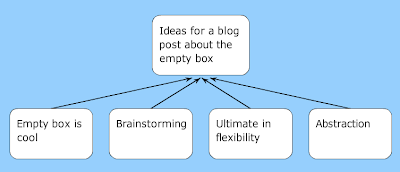Want to grab attention like a front page journalist? The Inverted Pyramid style of writing is one of the keys. What is it, and how can bCisive and Rationale help you to learn to how to do it, and keep on doing it?

The inverted pyramid
What is it?
The
Inverted Pyramid style of writing is commonly seen in print journalism, where it allows the reader to leave off reading at any point, and still have the gist of the story. It is also an excellent style when writing for busy people, because it gives a summary at the start, then delves into increasingly more detail, rather than "building up suspense".
How to do it
Here's an example of a list of facts to be assembled into a news article (
source article):
An accident occurred. It happened yesterday. Today is Tuesday. The accident was a car accident. It happened in Murfreesboro where Main Street and Broad Street intersect. One person was killed. The person was John Frazier. He was 20 years old and lived in Murfreesboro at 212 Moore Court. He was driving a blue 1998 Ford Mustang. He was driving northwest on Broad Street at about 5 p.m. He lost control of the car. It was raining, and the road was slick. He was also driving about 20 mph over the speed limit. He was the only one in the car. The car smashed into a utility pole along Broad Street. The impact crushed the whole front of the car. Frazier was thrown through the car's windshield. He landed on the pavement some 20 feet away. He wasn't wearing a seat belt. He was killed instantly.
Let's organize these visually, under the headings What?, When?, Who?, Why? and How?:

The facts arranged visually (click for full size)
In this case I have not only classified the facts by placing them under the relevant questions, but also arranged them in order of importance. The most import facts respond directly to the questions, with elaborations below.
To draft the start of an Inverted Pyramid style story, I simply hide the lower reaches of my map:

The top of the map gives a visual summary
A suggested first sentence draws on all these elements, quickly summarizing the situation:
A Murfreesboro [Where] man [Who] died [What] Monday afternoon [When] when his car spun out of control [How] on rain-slickened [Why] Broad Street [more Where], crashed into a utility pole and threw him through the windshield [more How].
The rest of the story can be constructed by delving into more detail mainly around one of the top level questions at a time.
A visual approach
By using
Rationale or
bCisive (in this case I used
bCisive Online) you can quickly and visually
organize your facts so that they are not just listed, but
well structured. From there the structure of your writing will follow easily, and it just remains to polish the prose so that it sounds good too.
Being able to easily drag and drop the pieces and have the layout automatically adjust makes the use of such tools much quicker and easier than using pen and paper or whiteboard, or text-editing or straight drawing software.
Finally, export a text form of your map to create the basis for the final, well-structured, written version.


























